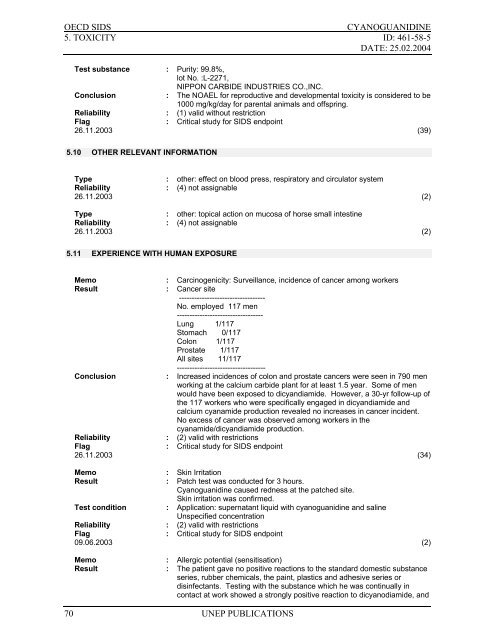Cyanoguanidine CAS N°: 461-58-5
Cyanoguanidine CAS N°: 461-58-5
Cyanoguanidine CAS N°: 461-58-5
Create successful ePaper yourself
Turn your PDF publications into a flip-book with our unique Google optimized e-Paper software.
OECD SIDS<br />
CYANOGUANIDINE<br />
5. TOXICITY ID: <strong>461</strong>-<strong>58</strong>-5<br />
DATE: 25.02.2004<br />
Test substance : Purity: 99.8%,<br />
lot No. :L-2271,<br />
NIPPON CARBIDE INDUSTRIES CO.,INC.<br />
Conclusion : The NOAEL for reproductive and developmental toxicity is considered to be<br />
1000 mg/kg/day for parental animals and offspring.<br />
Reliability : (1) valid without restriction<br />
Flag : Critical study for SIDS endpoint<br />
26.11.2003 (39)<br />
5.10 OTHER RELEVANT INFORMATION<br />
Type : other: effect on blood press, respiratory and circulator system<br />
Reliability : (4) not assignable<br />
26.11.2003 (2)<br />
Type : other: topical action on mucosa of horse small intestine<br />
Reliability : (4) not assignable<br />
26.11.2003 (2)<br />
5.11 EXPERIENCE WITH HUMAN EXPOSURE<br />
Memo : Carcinogenicity: Surveillance, incidence of cancer among workers<br />
Result : Cancer site<br />
----------------------------------<br />
No. employed 117 men<br />
----------------------------------<br />
Lung 1/117<br />
Stomach 0/117<br />
Colon 1/117<br />
Prostate 1/117<br />
All sites 11/117<br />
-----------------------------------<br />
Conclusion : Increased incidences of colon and prostate cancers were seen in 790 men<br />
working at the calcium carbide plant for at least 1.5 year. Some of men<br />
would have been exposed to dicyandiamide. However, a 30-yr follow-up of<br />
the 117 workers who were specifically engaged in dicyandiamide and<br />
calcium cyanamide production revealed no increases in cancer incident.<br />
No excess of cancer was observed among workers in the<br />
cyanamide/dicyandiamide production.<br />
Reliability : (2) valid with restrictions<br />
Flag : Critical study for SIDS endpoint<br />
26.11.2003 (34)<br />
Memo : Skin Irritation<br />
Result : Patch test was conducted for 3 hours.<br />
<strong>Cyanoguanidine</strong> caused redness at the patched site.<br />
Skin irritation was confirmed.<br />
Test condition : Application: supernatant liquid with cyanoguanidine and saline<br />
Unspecified concentration<br />
Reliability : (2) valid with restrictions<br />
Flag : Critical study for SIDS endpoint<br />
09.06.2003 (2)<br />
Memo : Allergic potential (sensitisation)<br />
Result : The patient gave no positive reactions to the standard domestic substance<br />
series, rubber chemicals, the paint, plastics and adhesive series or<br />
disinfectants. Testing with the substance which he was continually in<br />
contact at work showed a strongly positive reaction to dicyanodiamide, and<br />
70<br />
UNEP PUBLICATIONS
















